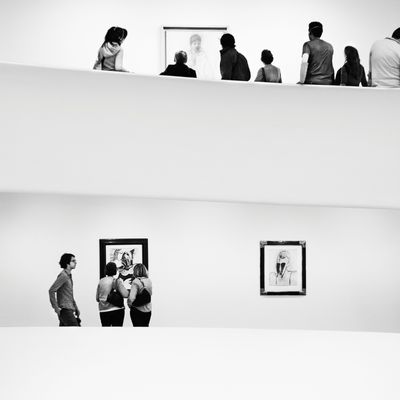
Over the past five years, New York museums and galleries have been awash in Picasso shows. IÔÇÖve seen so many that I thought it was time to give the Spanish whirlwind a rest. I was wrongÔÇöway wrong. Picasso Black and White, at the Guggenheim, is a show so clear, declarative, and revelatory that it shakes you awake, and makes you think, At last: Picasso like IÔÇÖve never seen him, in his kitchen, in his wheelhouse. Brilliantly conceived and installed by Carmen Gim├®nez, the show zeroes in on PicassoÔÇÖs use of black and white and gray, a motif that spanned his entire career, one that he never set aside and often employed at breakthrough moments. Compressing Picasso this way reveals the extraordinary inner architectonics of his work, the crucial structural templates and variants that convulsively propel his inventiveness. The relentless focus brings into view PicassoÔÇÖs revolutionary system of seeing and depicting.
Of the nearly 120 pieces of art on view, 38 works have never been seen in this country before. Five have never been shown anywhere. (HowÔÇÖd that happen?) I was so jazzed by what I was seeing that, about two thirds up Frank Lloyd WrightÔÇÖs spiral, at the point in most Guggenheim shows where I feel the artists or curators running out of gas or trying to cobble together a last transition, I realized I hadnÔÇÖt seen a clunker yet, and what I could see ahead looked even stronger.┬á
The rap on Picasso during his lifetime and even today is that Matisse, not he, was the colorist. Picasso was the draftsman, the graphic master. (And, after all, who doesnt love Matisses cosmic secret garden of color?) Ever competitive, Picasso regularly addressed the criticism himself: Color weakens; I use the language of construction; If you dont know what color to take, take black. Picassos own dealer said he was indifferent to  color. I disagree, and concur with late MoMA curator and wild-man Picasso maniac, William Rubin, who crowed that Picasso was one of the great colorists of the century. Picasso is more of a hyena of color, rash, using it to reveal his animal-being, Yeatss terrible beauty, omega points of form. For Picasso, black and white are colors, and so are the thousand shades of gray in between.
This show lets us see Picasso in a clarifying light, creating bodies without mass, densities made of ashes, forms that thwart the ability to interpret, conceptual beings that spring to the fore into unknowable dimensions. As I reached the top level of the ramp, where the show moves into the late stages of PicassoÔÇÖs career that academics still disparage, the monochromatic lens had allowed me to reaffirm how powerful, particular, and acute PicassoÔÇÖs later work is, how his restraint deepened his passion by refusing to give it easy vent. In these late pictures of old men caressing voluptuous women, eyes wide open, mouths agape, bodies entwined, kissing has never looked so sexual, desperate, devouring. I glimpse eternity in these dying kisses.┬á
The elimination of traditional color lets you understand what Leo Steinberg meant when he said that Picasso presents a ÔÇ£bent vision.ÔÇØ You see his dual view of the world Platonically and sexually. As you look, feel your eye move easily, unconsciously, desirously all the way around PicassoÔÇÖs bodies and shapes. Things seem to be seen from behind and in front at once, inside and out, from above and below. Your vision moves into crannies of bellybuttons, the eye traces thighs, heads thrown back. That all of this is taking place in a highly abstracted realm, barren of color, increases the intimacy, perversity, and complexity of these disjunctive images.┬á
The 1937 earth-shaker Guernica doesnÔÇÖt travel from its permanent home in Madrid, but one of its close pictorial relatives is here. The Charnel House, finished the last year of World War II, is a horror-show history picture ripped out of the black-and-white newsreels of the time. ItÔÇÖs a snaggletoothed jigsaw of destruction, giving us rumors of annihilation in death camps, severed limbs, thickets of snaking lines, mouths with no moisture, all beneath a stately still life, which, seen only in outline, becomes a ghostly stand-in for Europe itself. Nearby is an overscale gouged bronze lump titled Skull. So much for the idiot snipingÔÇöand you do still hear itÔÇöthat Picasso didnÔÇÖt have a bad war.┬á
There are masterpieces of Analytic and Synthetic Cubism, pictures that seem to pixelate into flickering cave portraits. One incredible series of works points directly into MoMAÔÇÖs insurrectionary powerhouse Les Demoiselles dÔÇÖAvignon. The figures are Cycladic-like or early Iberian, with hollowed-out eyes that gape as we gape back. In one painting, some striding beings loom toward us like geometric zombies from the afterlife. A wonderful surprise in this show is how late into the thirties images linger of the ever-sensuous, highly sexualized Marie-Th├®r├¿se Walter, PicassoÔÇÖs midlife mistress and muse.
I made my way back down the ramp filled with tenderness and wonder, and in the rotunda, I was stunned by a sculpture that IÔÇÖd missed, somehow, on the way in. ItÔÇÖs a large bronze statue from 1933, a copy of which adorns PicassoÔÇÖs grave at Vauvenargues in the south of France. We see a hulking, bulbous, powerful phallus-shaped female form. She offers some sort of goblet to the world with a hugely engorged, distended right arm. Her left arm is gone, either devoured by Picasso or life, or reaching inward onanistically to herself. By means of this profound level of abstraction Picasso brings form into the realm of poetry.┬á┬á┬á┬á┬á┬á┬á┬á┬á┬á┬á┬á┬á┬á
Picasso Black and White, Solomon R. Guggenheim Museum, Through January 23.
*This article originally appeared in the November 5, 2012 issue of New York Magazine.

